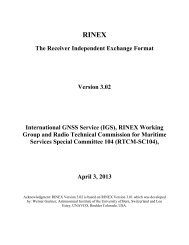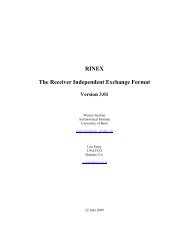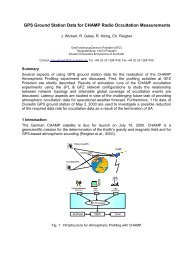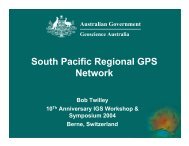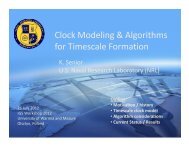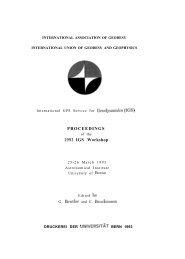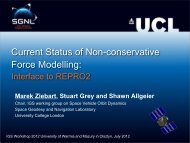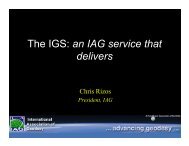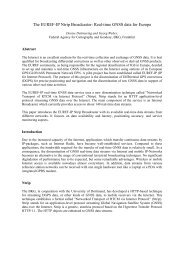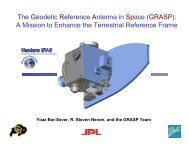(c)(d)quality assessment and feedback to RAC’S and GAC’S, ultimately resulting in a better,more robust <strong>IGS</strong>. The problem of quality assessment for hundreds of stations per dayis daunting, but can be realistically achieved with a distributed system.Note that it expected that groups will serve in 2 or 3 of the above capacities,The system will accommodate those who have the most stringent accuracyrequirements. It will also accommodate those who have less stringent requirements, butcertain inputs to the system will have to at least meet certain accuracy standards. Indesign issues where there is a trade-off between achievable accuracy versus practicalissues such as computational burden, accuracy will have the highest weight except forcases where either (i) productivity y would be reduced to an intolerable level, or (ii) itwould be unreasonable to expect those affected to abide by the standard procedures. Inany case, accuracy must meet a specified standard (given below). Not meetingaccuracy standards should be regarded in the same way as a failure of a systemcomponent.The system will be designed so as not to limit regional baseline rrns accuracy to beworse than 5 mm + 10-8L in the horizontal components (where L is baseline length)and 20 mm + 1O-8L in the vertical component. For absolute coordinate accuracy (inthe global terrestrial frame), the system will be designed so as not to limit the rmspositioning accuracy to be worse than of 10 mm horizontal and 25 mm vertical. Theserequirements are to be interpreted as “anywhere on the globe,” and additionaldensification of the globaJ network maybe necessary.(e) The system will verify that the accuracy requirements are being met at several regionsthat tie well-distribu~ed around the globe, ~d provide sufficient feedback to analysiscenters for them to take appropriate action as necessary.(f)RAC’s and other users of <strong>IGS</strong> global products will be given the means to produceregional results that meet agreed upon standards. These means should include (but notbe limited to) sufficient information, recommendations, troubleshooting hints, feedbackprocedures, processing standards, possibly software tools and user guides, and ameans of assistance in case of inquiries and analysis questions.(g) There must be some standardized quantification of satellite orbit errors in <strong>IGS</strong> products,at least for those orbits that are degraded to the point that they will significantly affectregional baseline accuracy; and there needs to be explicit recommendations/instructionson how to use these indices for various user situations.(h) <strong>IGS</strong> will develop and provide the means for analysis centers and other users to easilyextract the standard coordinates of sites at an arbitrary epoch. This includes softwaretools, eccentricity information, phase center offsets, seismic displacements, andanything else that is pertinent.(i) <strong>IGS</strong> will develop explicit instructions, analysis standards, formats, recommendations,etc., to RAC’S and GAC’S who wish to submit their network solutions to <strong>IGS</strong> foreventual incorporation into the global network solution. Along with their solutions,region~ centers will provide <strong>IGS</strong> all pertinent information in some standard electronicform to be decided (e.g., assumed antenna heights, analysis strategy, etc.).67
@ <strong>IGS</strong> will develop instructions, analysis standards, formats, recommendations, etc., toNAC’S who will take ensembles of regional cluster solutions and routine globalsolutions to form full global solutions,(k) The. system will have a centralized component (under the supervision of the CentralBureau) that screens andassesses con~ibuted solutions frdm GAC’s, RAC’S, andNAC’S, and provides feedback to them. While any center can act to produce their ownfully combined solution, <strong>IGS</strong> must also, in cooperation with the IERS, develop astandard solution for purposes expressed in item 2,1 (h).(1)<strong>IGS</strong> will encourage participation of many RAC’S and NAC’S as part of its research anddevelopment strategy to incrementally improve products and-customer services bybroadening its pool of active participants, <strong>IGS</strong> will draw up a plan regarding“membership” as a RAC or NAC. The most obvious mechanism is to accept RAC’Sand NAC’s as “Associate <strong>Analysis</strong> <strong>Center</strong>s” as defined in the <strong>IGS</strong> Terms of Reference,(m) (i) GAC’S should use as many globally distributed stations in common (to all GAC’S)as possible. More commonality will result in more robust network combinations anddetection of errors. For purposes of this document, we call these “common stations”.It is recommended that a list of common stations be discussed and agreed upon,keeping in mind the goals set forth in this document.(ii) RAC’S should use at least 3 “common stations” in the reduction of the regionalnetwork data. Although strictly speaking, only 1 common station is necessary for astable origin (the orientation being defined by fixing the GAC orbits), 3 arerecommended for (i) more robust network combinations, and (ii) assessment of errors,by comparing RAC and GAC solutions for the common stations. Apart from qualitycontrol, the assessment of errors will allow for better weighting schemes to bedeveloped for network combinations, and for detection and first-order correction ofanomalous regional network rotations and distortion (possibly due to GAC orbiterrors).(iii) The list of common stations should be sufficiently globally distributed and densesuch that any potential regional survey can be contained within a polygon of at least 3common stations, with at least one common site within 2000 km of the regionalnetwork. If this is not possible with the current global network, then we recommendthat <strong>IGS</strong> strive to ensure that future global sites be installed to meet this standard. Forpermanent regional arrays, this condition can be easily met by including at least onestation from each of the regional arrays on the list of common stations. The map onthe next page (Figure 3) shows the current status of the global network, where the solidline is the 2000 km contour.68
- Page 1 and 2:
●INTERNATIONAL ASSOCIATION OF GEO
- Page 3 and 4:
TABLE OF CONTENTS.FINAL AGENDA . .
- Page 5 and 6:
13:30 NGS14:00 S1014:30 EMR15:00 CO
- Page 7 and 8:
LIST OF PARTICIPANTS:Prof. Gerhard
- Page 10 and 11:
Table 1. Current IGS Analysis Cente
- Page 12 and 13:
The first field identifies the reco
- Page 14 and 15:
Summary InformationThe third produc
- Page 16 and 17:
From Figure 1 we find that there ar
- Page 18:
to define a reference clock in thei
- Page 22 and 23: SESSION 2(IGS orbit products)
- Page 24 and 25: 1. introductionThe main objectives
- Page 26 and 27: ecause of the above averaging. This
- Page 28 and 29: RMS per center (m)o 0 0 0 0 0 oA0Iv
- Page 30: Scale (ppb)I I I I I 11+-b~ul0Amo&I
- Page 33 and 34: and NGS. Note that the day to day v
- Page 35 and 36: Rotation around X-axis (mas)1&0 0o
- Page 37 and 38: discussed in Section 3 are here see
- Page 39 and 40: -----------------------------------
- Page 41 and 42: Residuals in Meters1 1 1 1 1 1 1=%m
- Page 43 and 44: Residuals inMeters11111cnficJJw-o A
- Page 45 and 46: I I I—Residuals in Meters..—.
- Page 47 and 48: 1111ResidualsMeters,—{44
- Page 49 and 50: Residuals in MetersI I I II I I IIc
- Page 51 and 52: Rms in MetersI 1 ! I 1 10 n0 a0n.ff
- Page 53 and 54: IGS- and the COM-sets, but that the
- Page 55 and 56: Table 4.1 N.A. Baseline Repeatabili
- Page 57 and 58: ..Figure 5.1:Clock solutions for FA
- Page 59 and 60: specifically the preanalysis can be
- Page 61 and 62: discussion, a question as to whethe
- Page 63 and 64: SUMMARY OF SESSION 3This Session be
- Page 65 and 66: IGS POSITION PAPER, IGS ANALYSIS CE
- Page 67 and 68: and Earth orientation parameters (E
- Page 69: LbPIERS and IGSCentral Bureausand D
- Page 73: 2.2 Analysis Center System DesignFi
- Page 76 and 77: applied to the solution in order to
- Page 78 and 79: ..standard deviations. This is conv
- Page 80 and 81: known, the two solutions will be ad
- Page 82 and 83: errors, and can therefore be used a
- Page 84 and 85: International Terrestrial Reference
- Page 86 and 87: Thus, there is the potential of fee
- Page 88 and 89: 90” 100” 110” 120” 130” 1
- Page 91 and 92: adiation parameters for each satell
- Page 93 and 94: Bock, Y., R.I. Abbot, C.C. Counselm
- Page 95 and 96: SUMMARY OF SESSION 4This session st
- Page 97 and 98: INTERNATIONAL EARTH ROTATION SERVIC
- Page 99 and 100: x- differences with IERS0.001”I I
- Page 101 and 102: SUMMARY OF SESSION 5In the last ses
- Page 103 and 104: 1) I(X3 PROCESSING/REPORTS/FORMATSS
- Page 105 and 106: IGS should foster and encourage reg
- Page 107 and 108: ..INTERNATIONAL GPS SERVICE FORGEOD
- Page 109 and 110: ortL.s.4
- Page 111 and 112: 1234567a91011121314IsIt17ItIs2C2122
- Page 113 and 114: . Ruth Neilan16S Central BureauJet
- Page 115 and 116: ON1T.>● Jim ZumbergeJet Propulsio
- Page 117: PROPOSED ORGANIZATION OF THE INTERN




